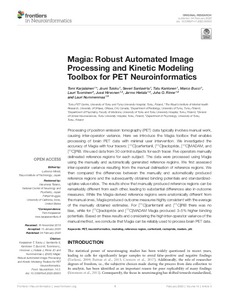Magia: Robust Automated Image Processing and Kinetic Modeling Toolbox for PET Neuroinformatics
Karjalainen Tomi; Tuisku Jouni; Santavirta Severi; Kantonen Tatu; Bucci Marco; Tuominen Lauri; Hirvonen Jussi; Hietala Jarmo; Rinne Juha O; Nummenmaa Lauri
Magia: Robust Automated Image Processing and Kinetic Modeling Toolbox for PET Neuroinformatics
Karjalainen Tomi
Tuisku Jouni
Santavirta Severi
Kantonen Tatu
Bucci Marco
Tuominen Lauri
Hirvonen Jussi
Hietala Jarmo
Rinne Juha O
Nummenmaa Lauri
FRONTIERS MEDIA SA
Julkaisun pysyvä osoite on:
https://urn.fi/URN:NBN:fi-fe2021042824418
https://urn.fi/URN:NBN:fi-fe2021042824418
Tiivistelmä
Processing of positron emission tomography (PET) data typically involves manual work, causing inter-operator variance. Here we introduce the Magia toolbox that enables processing of brain PET data with minimal user intervention. We investigated the accuracy of Magia with four tracers: [C-11]carfentanil, [C-11]raclopride, [C-11]MADAM, and [C-11]PiB. We used data from 30 control subjects for each tracer. Five operators manually delineated reference regions for each subject. The data were processed using Magia using the manually and automatically generated reference regions. We first assessed inter-operator variance resulting from the manual delineation of reference regions. We then compared the differences between the manually and automatically produced reference regions and the subsequently obtained binding potentials and standardized-uptake-value-ratios. The results show that manually produced reference regions can be remarkably different from each other, leading to substantial differences also in outcome measures. While the Magia-derived reference regions were anatomically different from the manual ones, Magia produced outcome measures highly consistent with the average of the manually obtained estimates. For [C-11]carfentanil and [C-11]PiB there was no bias, while for [C-11]raclopride and [C-11]MADAM Magia produced 3-5% higher binding potentials. Based on these results and considering the high inter-operator variance of the manual method, we conclude that Magia can be reliably used to process brain PET data.
Kokoelmat
- Rinnakkaistallenteet [27094]
